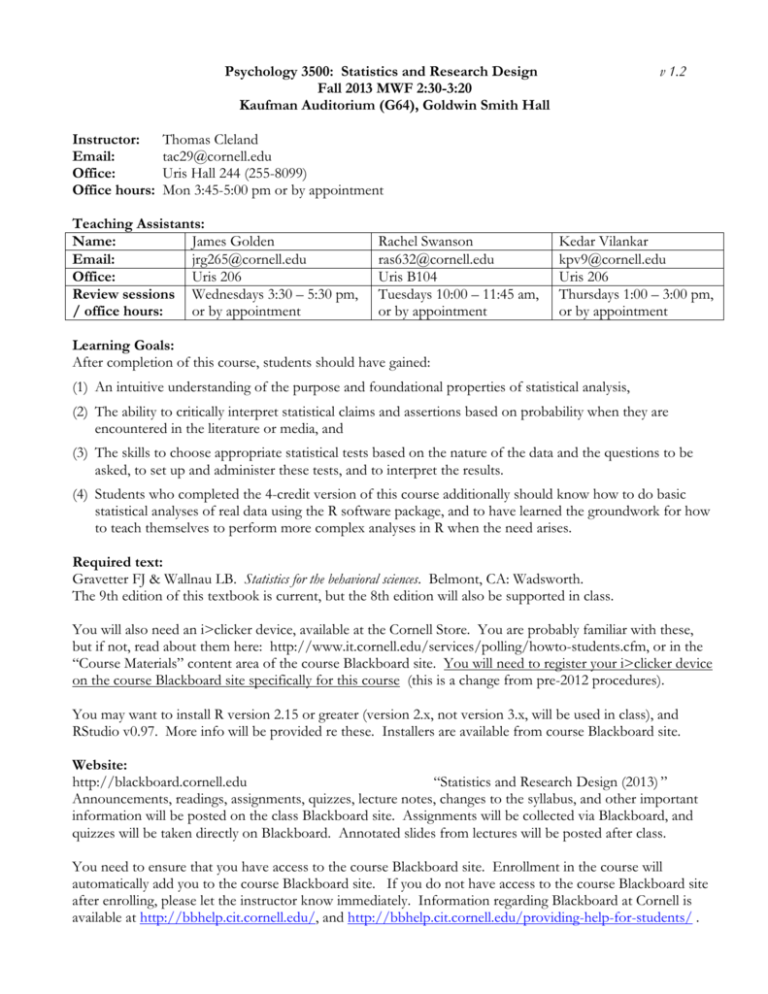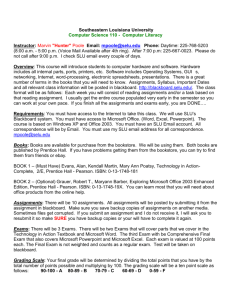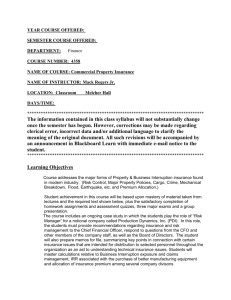Psychology 3500: Statistics and Research Design v 1.2 Fall 2013
advertisement

Psychology 3500: Statistics and Research Design Fall 2013 MWF 2:30-3:20 Kaufman Auditorium (G64), Goldwin Smith Hall Instructor: Email: Office: Office hours: v 1.2 Thomas Cleland tac29@cornell.edu Uris Hall 244 (255-8099) Mon 3:45-5:00 pm or by appointment Teaching Assistants: Name: James Golden Email: jrg265@cornell.edu Office: Uris 206 Review sessions Wednesdays 3:30 – 5:30 pm, / office hours: or by appointment Rachel Swanson ras632@cornell.edu Uris B104 Tuesdays 10:00 – 11:45 am, or by appointment Kedar Vilankar kpv9@cornell.edu Uris 206 Thursdays 1:00 – 3:00 pm, or by appointment Learning Goals: After completion of this course, students should have gained: (1) An intuitive understanding of the purpose and foundational properties of statistical analysis, (2) The ability to critically interpret statistical claims and assertions based on probability when they are encountered in the literature or media, and (3) The skills to choose appropriate statistical tests based on the nature of the data and the questions to be asked, to set up and administer these tests, and to interpret the results. (4) Students who completed the 4-credit version of this course additionally should know how to do basic statistical analyses of real data using the R software package, and to have learned the groundwork for how to teach themselves to perform more complex analyses in R when the need arises. Required text: Gravetter FJ & Wallnau LB. Statistics for the behavioral sciences. Belmont, CA: Wadsworth. The 9th edition of this textbook is current, but the 8th edition will also be supported in class. You will also need an i>clicker device, available at the Cornell Store. You are probably familiar with these, but if not, read about them here: http://www.it.cornell.edu/services/polling/howto-students.cfm, or in the “Course Materials” content area of the course Blackboard site. You will need to register your i>clicker device on the course Blackboard site specifically for this course (this is a change from pre-2012 procedures). You may want to install R version 2.15 or greater (version 2.x, not version 3.x, will be used in class), and RStudio v0.97. More info will be provided re these. Installers are available from course Blackboard site. Website: http://blackboard.cornell.edu “Statistics and Research Design (2013) ” Announcements, readings, assignments, quizzes, lecture notes, changes to the syllabus, and other important information will be posted on the class Blackboard site. Assignments will be collected via Blackboard, and quizzes will be taken directly on Blackboard. Annotated slides from lectures will be posted after class. You need to ensure that you have access to the course Blackboard site. Enrollment in the course will automatically add you to the course Blackboard site. If you do not have access to the course Blackboard site after enrolling, please let the instructor know immediately. Information regarding Blackboard at Cornell is available at http://bbhelp.cit.cornell.edu/, and http://bbhelp.cit.cornell.edu/providing-help-for-students/ . Assignments: Written assignments will be posted in the “Assignments” content area on Blackboard. Each assignment will have two similarly-named entries: one standard entry from which you will download the assignment file in your favorite format, and one Turnitin entry where you will turn in your completed assignment via the “View/Complete” link. All assignments must be turned in electronically via Blackboard’s Turnitin tool as well as on paper at the start of class. Please type if possible, and use plain (not lined) paper. Neatness/legibility will count. Assignments also may contain information regarding how to turn them in. Assignments must be turned in before 2:30 pm (= the start of class) on the day they are due to receive full credit. The final grade of a homework assignment will be reduced substantially for each day it is late; this includes turning it in after class has ended and including weekends. There will be 6 assignments in total. For some assignment questions, particularly full statistical analyses, you will be provided with the final answer along with the question. The goal of these questions is for you to ensure that you know how to do the problem from start to finish, so that if you do not get the same answer as the one provided, then you need to figure out what went wrong and do it again before turning it in. Your grade for these questions will be based on you showing your work logically, neatly, and clearly, including tables where appropriate, so that I know that you know what to do to get from start to finish. The idea here also is to prevent small arithmetic errors or misremembered details from spoiling your answers. Be sure that you allow adequate time for these problems. Assignments Using the R Statistical Programming Language: If you are taking the 4-credit option that includes training in the use of the R language/environment for statistical analysis, then you must complete the additional assignments posted in the “Assignments Using R” content area of Blackboard. Note that this course has “two sections” for some mysterious registrar reason, but in the end what matters to me is the credits and not the section. If you turn in the R-based assignments, then you should sign up for 4 credits; if not, then 3 credits. You can still learn and use R without turning in the R-based assignments, of course. Quizzes: There will be a quiz almost every week, each of which must be completed by SUNDAY night at 11:59 pm. (They are intended to be done on Friday, but you have till Sunday). You will take these quizzes entirely on Blackboard (under the “Quizzes” content area) and they will be automatically scored for quick feedback. They will include multiple choice questions as well as numerical answer questions (numerical answers will tolerate a small range of variability, so you don’t need to worry about rounding errors or the like). These quizzes will be reasonably good training for exams. There are 12 quizzes; your lowest score will be dropped. Exams: There will be two prelim exams and one final exam. Prelim exams will take place during class time. Exams are cumulative, and will emphasize a broad spectrum of material. You MUST bring a calculator to every exam! General communication devices such as smart phones are NOT allowed. The instructor may have some calculators available which you are welcome to borrow for a small fee that is payable in exam points. Audible electronic events during class, and especially during exams, may also incur a cost in points. If you have a conflict with an exam date (e.g., an athletic event or religious holiday), please discuss it with the instructor by the third week of the semester. There will be no make-up exams or quizzes after the fact except in the case of documented health emergencies. Students with Disabilities: Please give me your Student Disability Services (SDS) accommodation letter early in the semester so that I have adequate time to arrange your approved academic modifications. Meeting with me in my office hours will help ensure confidentiality. If you need an immediate accommodation for equal access, please speak with me after class or send an email message to me at tac29@cornell.edu and/or SDS at sds_cu@cornell.edu. If the need arises for additional accommodations during the semester, please contact SDS. Discussion Board: A forum entitled Feedback/Requests to Instructor has been created in the Blackboard discussion board for this course. You are welcome to use it to deliver feedback about any aspect of the course, particularly things that can be quickly improved. Anonymous postings are OK if it helps you to be more honest. Of course, I’d welcome your comments/requests in person as well. Also, feel free to create and/or participate in discussion threads about the course material that may arise for any reason. I and the TA(s) will check the discussion boards regularly and will try to answer any questions that may arise. Extra credit: To learn more about how research is conducted, I encourage you to participate in ongoing experiments for extra credit. You will receive one point of extra credit for each half-hour you spend as a participant in an experiment, up to a maximum of 5 points. Your extra credit points will be added to the score you receive on the final exam. Experiment signup is accessible via SONA at http://cornellpsych.sona-systems.com. Log in with your Cornell netID and you will see a list of studies. To participate, click on “View Timeslots” and select (a) timeslot(s) as appropriate. You will receive an email confirmation. After participation in a given study, you will be able to select the (participating) course for which you want the extra credit. Obviously, you can only participate once in each experiment. The last day that you can participate to earn extra credit is Monday, 9 December. Extra credit completed after that date will not be counted toward your grade in this course. Please keep separate proof of your completion of any extra credit work in case there is a glitch with the new SONA system. Plagiarism and Academic Integrity: I encourage you to work together so as to better understand the material presented in this course. However, the work you turn in for this course must be your own. Plagiarism also includes slight paraphrasing of another's words or sentence structure. University policies regarding plagiarism and other issues of academic integrity can be found at http://cuinfo.cornell.edu/academic/AIC.html. Grades: If you have a question about how an assignment, exam, or quiz was graded, you may contact the TAs for clarification, but any changes in grades are ultimately decided by the instructor. Requests for grade changes must be made in writing, presented within one week of the assignment/exam/quiz being returned, and must include a rationale for the change. The entire assignment, exam, or quiz in question will be re-graded; thus, the final score could increase or decrease. Please do not make a habit of grade grubbing for small points. It makes little difference in the end and annoys us all. If you legitimately think that a mistake has been made, of course, please feel free to query the TAs or instructor. Points will be deducted from assignments and exams if you do not label them as follows with your name and NetID. Electronically submitted assignments must include your name and NetID at the start of the document, and the filename must begin with your NetID (e.g., tac29_assignment1.docx). Please also label every physical page of paper assignments with your name and NetID. It's a good idea for exams, too. Estimated Contributions to Final Grade: Homework Assignments; also in-class participation, extra credit, etc. Quizzes (lowest score dropped and remaining scores averaged) Midterm exams Final Exam ~40% ~10% ~20% ~30% Estimated Course Schedule 2013 (v 1.2) Date *Bb quiz W 8/28 F 8/30 M 9/2 W 9/4 F 9/6 * M 9/9 W 9/11 (ADD) F 9/13 * M 9/16 W 9/18 F 9/20 * M 9/23 W 9/25 F 9/27 * M 9/30 W 10/2 F 10/4 * M 10/7 W 10/9 F 10/11 (no quiz) M 10/14 W 10/16 F 10/18 (DROP) * M 10/21 W 10/23 F 10/25 * M 10/28 W 10/30 F 11/1 * M 11/4 W 11/6 F 11/8 * M 11/11 W 11/13 F 11/15 * M 11/18 W 11/20 F 11/22 (PETITION) * M 11/25 W 11/27, F 11/29 M 12/2 W 12/4 F 12/6 * R 12/12, 7:00-9:30 pm Topic Introduction Variables, scales of measurement, methods LABOR DAY – NO CLASS Distributions, ranks, measures of central tendency Measures of central tendency; variability Variability, standard scores (z-scores) Probability, normal distribution, unit normal table Probability, binomial distributions, normal approx Distribution of sample means, SEM Hypothesis testing, errors, and statistical power Hypothesis testing, errors, and statistical power Bayes' theorem; frequentist vs Bayesian statistics Bayes’ theorem cont.; some techniques for using R PRELIM EXAM #1 (in class) NO CLASS t-tests: single-group designs t-tests: single-group, confidence intervals t-tests: two independent samples t-tests: two related samples (repeated measures) t-tests wrapup; signal detection theory intro FALL BREAK – NO CLASS Signal detection theory One-way ANOVA One-way ANOVA, post-hoc tests Repeated-measures ANOVA Factorial design, interactions, two-factor ANOVA Two-factor ANOVA; simple main effects ANOVA wrapup (Which test?); intro to correlation Pearson correlation Hypothesis testing; Spearman correlation Intro to regression Regression Review and Q/A with TAs PRELIM EXAM #2 (in class) Regression wrapup; recap Chi-square intro; goodness-of-fit Chi-square for independence Mann-Whitney U test Wilcoxon signed-ranks test THANKSGIVING BREAK – NO CLASS Kruskal-Wallace and Friedman tests Summary/Review (Which test?) Review and Q/A Final exam (Location TBA) Chapters, 9E (8E) Ch. 1-2 Ch. 2-3 Ch. 3-4 Ch. 4-5 Ch. 6; HW 1 Ch. 6 Ch. 7 Ch. 8 Ch. 8 Readings Readings; HW 2 Ch. 9 Ch. 9-10 (+12) Ch. 10 Ch. 11; HW 3 Readings Readings Ch. 12 (13) Ch. 12 (13) Ch. 13 (14); HW 4 Ch. 14 (15) Ch. 14 (15) Ch. 14-15 (15-16) Ch. 15 (16) Ch. 15 (16) Ch. 16 (17); HW 5 Ch. 16 (17) Ch. 16 (17) Ch. 17 (18) Ch. 17 (18) App. E (20) App. E (20); HW 6 App. E (20)







